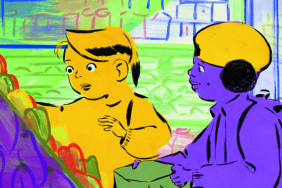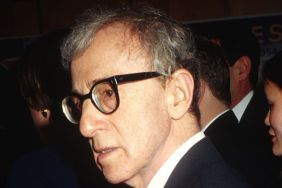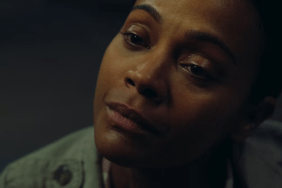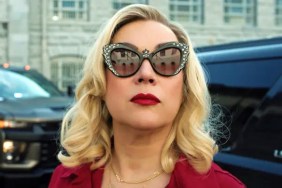In 2005, filmmaker Don Argott took a look at the inner workings of Paul Green’s School of Rock, a documentary that was so fun and entertaining it got adapted into the Jack Black comedy vehicle School of Rock. In his new documentary The Art of the Steal, which received raves and multiple sell-outs when it played at the Toronto and New York Film Festivals last year, Argott delves into a little known controversy that rocked the art world in the city of Philadelphia.
In 1922, Dr. Albert C. Barnes established Barnes Foundation, one of the greatest collection of arts by masters like Renoir and Cézanne and Matisse, in the suburb of Lower Merion, Pennsylvania, for the purpose of teaching and allowing the common man to view the beauty in a natural setting. After Barnes’ sudden death, the Foundation became entrenched in a power struggle to gain control of the billions of dollars of art in the collection. Finally, the city of Philadelphia stepped in and figured out a way to circumvent Barnes’ desires, as written quite clearly in his will, to keep all of the art in its place, with a decision to move all the art into the center of the city where it might be seen by more people and bring more tourism to the city. In other words, Barnes’ legacy was being foresaken in favor.
Because it’s fairly hard to sell a documentary about fine art to anyone, whether they’re an art lover or not, ComingSoon.net got on the phone with Argott last week to talk about the movie and get some more information about how he put the film together.
ComingSoon: Your previous documentaries explored the world of music and sports, which is very different to making a movie set in the world of art, so did you have any connections to that world before making this movie?
Don Argott: No, not at all. You know what? “Rock School” was really our baby. That was a project that we initiated and we funded ourselves and “Two Days in April” actually come to us from Netflix. They commissioned it and that’s how we did that. This project actually came to us through the executive producer Lenny Feinberg who really had a connection with the story, was someone who took classes at the Barnes Foundation about twenty years ago and lives in the neighborhood of the Barnes Foundation and has been closely following the story, the saga of the Barnes for a bunch of years. I think for him, he just saw that there was a big story there and really wanted to tell it in the documentary form. He found us and pitched the story to us and we thought it was a great story and decided to move forward with it. But you know for us, half the battle always is just finding good stories. We don’t want to get pigeonholed into making one kind of film or a political film or a music film or whatever because that’s kinda limiting yourself to the great stories that are out there. So we were fortunate to find this one. I think with the three films now that we’ve done, it shows that there’s a range there and hopefully just good storytelling. That’s the most important thing.
CS: When you do a film like this, you’re spending a lot of time putting it together and I wondered how personally invested you have to be in the subject matter, whether or not it’s just finding a great story and saying, “Hey, that’s a good story. I’m gonna find a way to tell it.”
Argott: The most important thing is to be invested in what you’re doing because believe me, there’s not enough money in it to just do it. (laughs) So we’ve probably started and stopped at least half a dozen to a dozen documentary projects where we go out and think that there might be an interesting story and then we find out that there’s just not enough there to pursue it. So the most important thing is to make sure that not only there’s enough of a story there, but something that you care to do because otherwise there’s an easier way to make a living than making a documentary that you’re not really passionate about. So I think we all had to really find the angle for all of us that worked on it to something that spoke to us and something that was important to us and I think we found it with this story.
CS: How did he pitch it to you? What sold you on doing this?
Argott: I mean first and foremost it was just that there was this present day kind of struggle going on against moving the art from one place to another. We were fortunate enough to kind of capture that as it was happening for like the last time and there’s an illegal battle going on in the courts for years and years and years with this story. We actually were fortunate enough to follow it as it was happening and it just happened that it was kinda the last one. The original intent was that there’s this place called the Barnes Foundation that’s moving the art from one place to the other and its breaking a man’s will. I mean, that was kind of the original pitch. Then we dug deeper and we saw how rich the story was and how many layers and twists and turns there are. For us as storytellers, it was amazing because there’s just never a lack. You have great characters–Barnes is a great character–you have good people that were involved in this story that just were amazing characters that have incredible egos. You have all these literally unbelievable things that happened within the story. I mean, you have Richard Glanton suing the neighbors as racist under the Federal Klu Klux Klan Act about a parking lot. Just when you think it can’t get any more bizarre, it kinda does. That’s great from a story perspective and it was really like, for us trying to figure out how to make it feel like this mystery, this thriller, this constantly moving story that would just keep taking you to new and interesting places and hopefully it succeeds in that.

CS: Did you actually know all that stuff going into it?
Argott: Honestly, it was a hell of a journey for all of us really. I mean, I think we all had different levels of knowledge about the story, but I would say that none of us involved knew what we were really in for. In terms of all of the stuff that we were able to uncover. A lot of it was covered pretty successfully in John Anderson’s “Art Held Hostage” book and that was a great guidebook for us to at least get the first half of the story, which is the Barnes and Annenberg struggle and then you had the Violette de Mazia era, and then you had the Richard Glanton era. But the book kinda ends at the end of the Glanton era for the most part, it doesn’t go into moving the art or anything like that. Obviously, the third act of the film is that, so that was a lot of us just digging and a lot of investigative reporting, that kind of stuff.
CS: Did you know a lot of the people in the art world and politics before this or did the producer have the connections you needed to get going with interviews?
Argott: No, we made kind of a wish list of people that we wanted to interview and we really wanted to have people that had an intimate connection with the story. We didn’t wanna have a lotta outsider people that just had opinions about it. You know, we’ve gotten criticized like, “Why haven’t you talked to this artist or this artist?” We didn’t want to have any fringe people. We wanted people that were involved in some fashion of the story and had an intimate connection to it because we didn’t want this kind of external voice of god, third person narrator to supplement the information. We wanted the people that kind of went through the process and were involved in the story to kinda tell you their story. I think it has a lot more legitimacy in that way because as soon as you start with a narrator in a story like this, it’s automatically imposing some kinda point of view. We’ve already gotten a point of view across without us imposing it, you know?
CS: Right. Well, it’s an interesting narrative to create from all of these interviews, using them to tell this story. I imagine you just conducted all of the interviews then transcribed them all and figured out a way to edit them together to flow as one story?
Argott: Yeah, pretty much. That’s how we work for the most part is we do a lot of research prior to the interviews and make sure we’re asking questions that are trying to get to where we want. John Anderson is somebody that was a pretty extensive interview because he almost becomes our narrator or default, our de facto narrator, because he wrote the book on the Barnes struggles for the most part. His was a pretty extensive interview and we knew that we wanted him to be kind of our guide in a way, but people like Richard Glanton, certainly asking him about his part of the story was critical and the neighbors and where they come into play and what was happening at that point. So it was very difficult in one respect because at the end of the day when you have all this footage, you just have a bunch of interviews that you have to start to figure out how do you weave it together and make it compelling and have it make sense without relying too much on supplemental graphics and text on the screen and that kind of stuff? So we tried to use that stuff sparingly and tried to have the people that were more involved in the story kinda like, recount the story.
CS: Glanton is an interesting case, because a lot of people declined interviews, and you would think that he’d be the first person to decline because he does come across rather badly.
Argott: I think part of it is that he’s got a tremendous ego and I gotta be honest, I have a lotta respect for Richard. I think he was vilified certainly and not for necessarily unjustly vilified. But, you see that he certainly had an agenda and he certainly has his place in the story, but he’s been looked at as he’s the bad guy and I think which for us, in the film, is that just when you think he’s the worst of ’em, I mean, he’s nowhere near. There are people way above him that are much more devious I guess you could say. Richard almost becomes kind of a sympathetic character where yeah, he had his own motives and he had his own agenda and it was all about Richard for the most part, but he still was in a way, at least upholding one part of keeping the Barnes where it was and trying to maintain it in it’s current location. You know, he was certainly trying to realize it as something else for kinda the 21st century. But he still was about keeping it there, not moving it.
CS: You talk about the agenda as a filmmaker. Was there ever an agenda to actually stop what was happening? Or, was it just a matter documenting what was happening?
Argott: No, not at all. We came into the story literally cold for the most part. I mean, Lenny obviously knew what was going on and he was deeply affected by the place and what it is ’cause he had taken classes there and I think he has a really emotional connection to it, but we didn’t at the time. We didn’t really have any agenda other than trying to tell a really great kinda hidden story. So, inevitably we get asked at this point, “Do you think that the film is gonna stop anything, or anything like that?” That was never our goal. I think the most important thing is getting this story out there and there’s certainly a lotta people that don’t know what has gone on there and I think it’s a pretty eye opening story. Once it gets out there into the public and it’s kinda up to them, how they feel about it and if they want to see if it compels them to rally and try to make a change. But that certainly was never our intention.

CS: I was wondering about that. As a documentary filmmaker, when you make a movie that tries to inform people about something that’s wrong that they wouldn’t approve, you would probably want to get them riled up to do something about it. In this case, your documentary covers some of that but it also seems to be something that can’t be stopped at this point.Argott: Yeah, it’s tough. I think that again, I personally don’t like films that have a call to action at the end. There’s certainly documentaries like that like “An Inconvenient Truth” and “Food, Inc.” are two examples. Certainly “Food, Inc.” is an extremely powerful film, like amazing filmmaking. At the end there’s this whole bit about what you can do. I’m not faulting the filmmakers for that, but me personally, I kinda got turned off by that. You know, it’s this idea of like, “Okay, now you have the information, now this is what you should do with all this information.” That was kind of a turn off for me and I think it would be a turn off for a lotta people if at the end we put a graphic up saying like, “This is how you can get involved to go to stop the Barnes,” because that’s not the point of the film that we made. If it compels people to want to do something, then that’s great, but we’re not the activists out there leading the charge to stop the move.
CS: You didn’t put the mayor and the governor’s phone number at the very end.
Argott: (Laughs) Yeah, right.
CS: With all the people talking about what a travesty moving the art would be, were any of these people around when a lot of this stuff was first going down? I was really surprised that so many people were talking about what happened and were aware at an early enough stage where something could have been done to stop the move.
Argott: There are so many things. That’s one of the amazing things inherent to this story is that there was so much that could’ve been done throughout the course of the past at least 20 years with Richard Glanton. If you think about it, if Richard Glanton would have gotten together with the neighbors and they came to some kind of moderate solution to figure out their parking problems, I wouldn’t be here talking to you, you know what I mean? Really the essence of this whole thing was that at that point, Richard Glanton wanted it to be art on tour and brought it back to all this fanfare and kinda transformed this kinda sleepy suburb into like the art destination for everybody in the world to come and see it. If there had been a more moderate solution to that other than, “The neighbors are racist and I’m gonna sue them under the Federal Klu Klux Klan Act over a parking lot” basically, that would’ve changed the course of this thing. Even backing up prior to Glanton, if Franklin Williams would’ve lived, he certainly had a sense to uphold what this place was, what Lincoln University were being entrusted with. He died suddenly and then Richard Glanton comes in with his own agenda. After that, there’s all this frivolous spending on lawsuits and this, that and the other thing. There just is so many points in this story where things couldn’t be worked out. On the surface it seems like a very simple way to work it out and there was always this extreme example to the end result which is basically, “We can’t make it work here, so let’s move it to Philadelphia and spend hundreds of millions of dollars doing it.” Like, the whole idea of a small foundation like the Barnes to sustain for their total operating budget, they have a shortfall of like, a million or a million and a half dollars a year that they have to make up in some kinda donors and everything, with donors and sponsorship and stuff. So to remedy that, let’s totally move it five miles away in downtown Philadelphia and spend upwards of who knows what it’s gonna cost? That’s the other thing, we don’t know. But, so let’s just say at the end of the day it costs $300 million to solve a million and a half dollar a year problem, that just seems extreme.
CS: I hate to play devil’s advocate, but at any point did you see any pluses in moving the collection? Obviously, there are a number of good arguments made in the film – more people will see it, the neighbors won’t have to deal with the traffic, etc.
Argott: Personally, knowing what I know and knowing how things could’ve been different and how things could be preserved there, I don’t really see any benefit to this. I don’t see any benefit certainly of spending tax money to move this collection. I mean, as a taxpayer of Philadelphia that pisses me off. So I don’t really see the big benefits. I think if our film hadn’t come out and really kinda showed what’s going on there for as long as it’s been going on, I think that the Barnes would’ve moved kind of quietly in the night and been erected in this new beautiful building on the parkway and everybody would’ve been like, “Wow, this is amazing. It’s good for tourism, awesome.” A couple years would go by and they would have the same problems as the art museum is having right now which is the arts are suffering all over the place, not just in Philadelphia, but everywhere. I mean, the reality is that there’s only so much money to go around and there’s only so much philanthropic people out there that are supporting them. So you’re basically adding another strain to that by moving this collection to the parkway. I mean, they’re gonna be fighting for the same sponsor and donor streams that the art museum and all the other museums in Philadelphia are fighting for. So it’s gonna be difficult and I haven’t seen the business plan of how this is supposed to work and how it’s going to maintain in it’s new location or how much it’s actually going to cost at the end of the day. No one has put those numbers out there, so that’s troubling to me.
CS: I know you have a musical background, so I wanted to ask about the version of “Iron Man” at the beginning of the movie, is that your band doing that?
Argott: No, it’s actually a band called The Bad Plus. We used to do a lotta work for SONY Music and we did a lotta their behind the scenes and EPK stuff and we did a thing with The Bad Plus, we shot their concert and we got to know those guys and they do a lot of really avant garde jazz covers. I know they do “Everybody Wants to Rule the World” by Tears for Fears and “We are the Champions.” “Iron Man” was one that we used. I think like, for us, because we do have a music background and kinda more of a rock and roll sensibility that we really wanted to kick the film off with something that would shake the audience up to say like, “Okay, this isn’t gonna be a typical like, art movie with classical music and slow moves on paintings and stuff like this. This is gonna be much different than that.” So I think just having that piece in there kinda sets the tone for how the story’s gonna be told.

CS: I also understand you’re going to do maybe some dramatic feature sometime soon, is that possible?
Argott: Yeah, that got put on hold, the narrative thing that we were gonna do. I think there’s a couple more documentaries that we’ll make prior to that. We’re just trying to keep busy and keep making films and having this film out there and hopefully the film does well, but it’s already gotten a lot of attention, will afford us to at least continue making documentaries and I think we’re really fortunate to be able to do that.
CS: I was curious about “Ride Satan Ride” which is based on an album you did?
Argott: Demian Fenton, who is the editor of the film, and I, we actually have a band and we created a fictional soundtrack to a fake 1970’s satanic biker movie. So then we worked backwards and we actually found somebody to write a script for our soundtrack and so that was gonna be our next project, but right now, it looks like that’s on hold for a little while.
CS: What kinda budget were you looking for that? Was it going to be a fairly small budget?
Argott: Oh yeah, yeah, very much. It was totally in the vein of those 70’s exploitation films. They embraced the limitations and the budget that they have. We also want to set it in the 70’s which is difficult to do on a low budget too, so it’s probably gonna be a little while before we get to that. But yeah, I definitely don’t want to just do documentaries. I would certainly like to make narratives and all kinds of narratives. I think just having these three documentaries shows that we can kinda do any kind of film and I don’t want to just make 70’s exploitation films. I want to do a narrative, I want to make comedies, whatever. There’s so much work out there to do and we’re very fortunate that we’re making a living in the film industry, which is not an easy thing to do.
CS: Do you know what the subject for your next doc will be? Do you have any idea yet?
Argott: I have three that we’re working on and we’re not sure which one is gonna be the next big one. So I don’t want to put it out there.
CS: Right, maybe it’s just working on the research and figuring that out. Have you been keeping in touch with the Barnes at all as far as what’s going on with that move?
Argott: Right now it’s set to move in 2012.
CS: Oh, it’s two years away. A friend just went to visit a couple weeks ago and she thought it was moving sooner than that.
Argott: No, there’s just a lot of misinformation out there. It’s still open. People can go see it and they should go see it. I know they’re starting to close some galleries to do conservation for some reason, but it’s still open to the public and you should go and see it before they destroy it.
CS: That sounds like a great way to end the interview.
Argott: Thanks a lot, man.
The Art of the Steal opens on Friday, February 26 at the IFC Center and Lincoln Plaza Cinemas, and is available On Demand starting February 24 in other areas.









